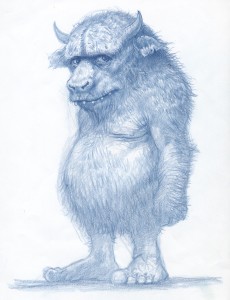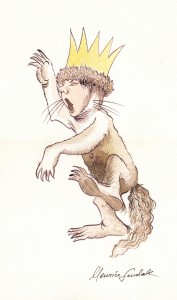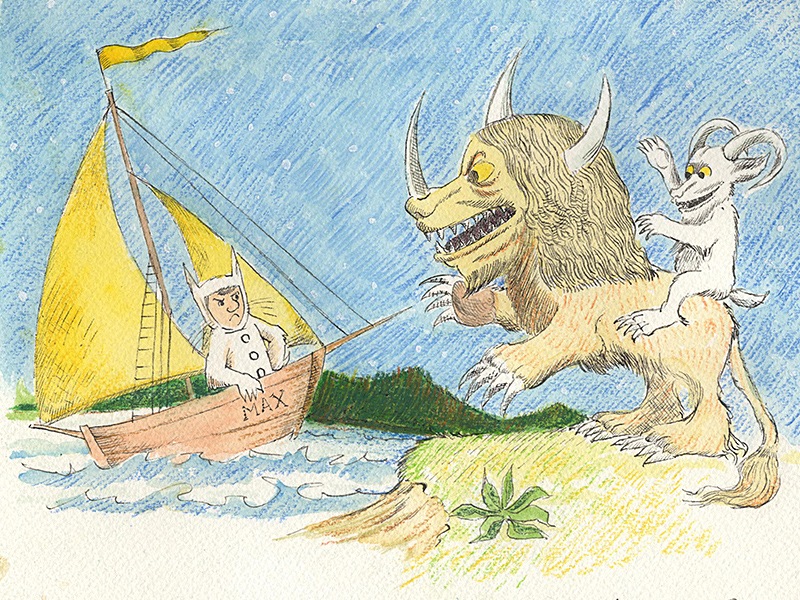The Toronto Reference Library is hosting a travelling exhibition of original artwork by Maurice Sendak, the author and illustrator of the 1963 children’s classic, Where the Wild Things Are.
Aimed at three- to five-year-olds, the book portrayed the darker side of childhood, including temper tantrums and bad behaviour, at a time when picture books offered safe, sanitized and happy-go-lucky versions of childhood. Sendak is “beloved for capturing the more complex feelings of childhood,” said Nicole Dawkins, gallery and exhibit curator at the Toronto Public Library.

Developed in 2012 by the AFA NYC gallery, the multimedia exhibit features illustrations from Where the Wild Things Are and other works by Sendak, as well as set and costume designs for operas and theatrical productions, animation cels, posters and sketches of wild things that Sendak gave to his fans and friends.
In Where the Wild Things Are, Sendak’s young hero, Max, is sent to bed without supper after misbehaving. That night, a forest grows in his room and an ocean rushes by with a boat to take him to the place where the wild things are. There he faces his fear and anxieties, depicted as horned monsters with clawed feet and yellow eyes, and confronts them.
The book won the prestigious Caldecott Medal for most distinguished picture book in 1964, while at the same time, it was banned in libraries across the United States for its dark undertones and lack of moralizing. The renowned psychiatrist Bruno Bettelheim was critical, too, but from a different angle. He maintained that the story of a boy who’s sent to his room without supper for misbehaving would traumatize the book’s audience. Far from becoming traumatized though, children loved and related to the simple 338-word story of how Max tames the beasts by staring into their eyes without blinking.
Where the Wild Things Are was an expression of Sendak’s lonely and difficult childhood. According to the website Mental Floss, his mother, Sarah, was emotionally unbalanced, and Sendak has described himself as a sickly child who escaped by drawing in his room.
His parents were Jewish immigrants from Poland. At Sendak’s bar mitzvah in 1941, his father, Philip, got the news that the Nazis had destroyed his shtetl and murdered the village’s Jews or sent them to concentration camps. So the Holocaust was a cloud that hung over Sendak’s family home in Brooklyn, N.Y., during his teen years.

The inspiration for the term “wild things” came from Sendak’s mother. As a child, when he drove his mother nuts, she would call him a “vilde chaye,” meaning “wild animal” in Yiddish.
When developing the monsters for the book, Sendak, who died in 2012, drew on his childhood memories of his immigrant relatives. “That’s what art is. I mean, you don’t make up stories, you live your life,” Sendak has said.
According to Mental Floss, his uncles and aunts would come on Sundays and “all say the same dumb things,” he once recalled. “How big you are, how fat you got, and you look so good we could eat you up. So the only entertainment was watching their bloodshot eyes and how bad their teeth were. You know, children are monstrously cruel about physical defects – the hair curling out of the nose, the weird mole on the side of the head. And so, you would glue in on that and then you talk about it with your brother and sister later. And they became the wild things.”
At the Toronto Reference Library’s Sendak exhibit, kids can board a re-creation of Max’s boat and use a digital touch screen to choose different backgrounds for wild things and create their own scenes. Sendak Preschool Time from 10 to 10:30 a.m. on Jan. 12, 19 and 26 in the library’s TD Gallery features stories, songs and rhymes inspired by Sendak’s work for children ages three to five, with their parents or caregivers.
The exhibit at the Toronto Reference Library continues until Jan. 31. A related exhibit at the Lillian H. Smith branch of the Toronto Public Library that showcases more of Sendak’s work and the work of artists and innovators who inspired him runs until March 5. For more information, click here.
